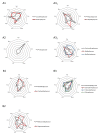What Is in Store for EPS Microalgae in the Next Decade?
- PMID: 31775355
- PMCID: PMC6930497
- DOI: 10.3390/molecules24234296
What Is in Store for EPS Microalgae in the Next Decade?
Abstract
Microalgae and their metabolites have been an El Dorado since the turn of the 21st century. Many scientific works and industrial exploitations have thus been set up. These developments have often highlighted the need to intensify the processes for biomass production in photo-autotrophy and exploit all the microalgae value including ExoPolySaccharides (EPS). Indeed, the bottlenecks limiting the development of low value products from microalgae are not only linked to biology but also to biological engineering problems including harvesting, recycling of culture media, photoproduction, and biorefinery. Even respecting the so-called "Biorefinery Concept", few applications had a chance to emerge and survive on the market. Thus, exploiting EPS from microalgae for industrial applications in some low-value markets such as food is probably not a mature proposition considering the competitiveness of polysaccharides from terrestrial plants, macroalgae, and bacteria. However, it does not imply drawing a line on their uses but rather "thinking them" differently. This review provides insights into microalgae, EPS, and their exploitation. Perspectives on issues affecting the future of EPS microalgae are also addressed with a critical point of view.
Keywords: EPS; application; exopolysaccharides; market; microalgae.
Conflict of interest statement
The authors declare no conflict of interest.
Figures




References
-
- Richmond A. Handbook of Microalgal Culture: Biotechnology and Applied Phycology. 1st ed. Wiley-Blackwell; Hoboken, NJ, USA: 2004. p. 588.
Publication types
MeSH terms
Substances
LinkOut - more resources
Full Text Sources

